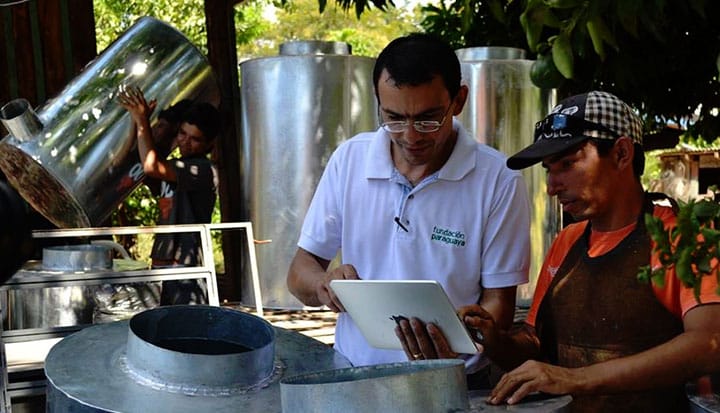At Fundación Paraguaya, we work with businesses to improve the standard of living of their employees. Many other organisations focus on this, but our approach as to how and why we are doing it is quite different. Read on, meet the Poverty Stoplight for Business and learn how it can leverage on collective intervention and attempt to eliminate poverty in the workforce.
It’s a matter of perspective
Back in 2013 the majority of the businesses we were in contact with, although having an advanced degree of legal compliance, working standards and wages, had not considered employees’ families or communities, focusing instead mainly on working conditions. So employees were still living in a context of poverty, and the companies all wanted to do something about it, but poverty as a problem is so difficult to deal with, that it seemed an insurmountable task. In the process, we came to realize that Businessmen usually hate problems but love problem solving. After all, problem solving is what defines entrepreneurs. So we asked ourselves, how about changing our perception of poverty from it being a problem to it becoming a challenge?
Action was sparked when we set a specific goal: “zero poverty” in our businesses. Semantics did its magic and everyone raised their hands to participate. Poverty in the workforce is difficult to acknowledge publicly, but having businesses without poverty was something everyone was willing to strive for. It was all a matter of perspective.
The Poverty Stoplight
The Poverty Stoplight is a methodology and metric that helps poor families identify and overcome poverty. Based on a user friendly visual survey that measures the families’ poverty, mentors guide them in designing and implementing a personalized poverty elimination plan that includes their motivation and skills. With the Poverty Stoplight, the overwhelming concept of poverty is broken down into smaller, more manageable problems, making the invisible visible through recognizable dimensions and indicators.
The indicators are represented by three definitions with corresponding images. Each image shows a scenario depicting what extreme poverty (coded as red), poverty (coded as yellow) and no poverty (coded as green) look like in the local context. In this way, the family self-identifies its own situation for each particular indicator. For example, in Paraguay the indicator “Access to safe drinking water” is depicted as follows:
Businesses Without Poverty
Regardless of the sector, size or location in which it is used, the Poverty Stoplight allows businesses to visualize their poverty challenge and have a benchmark to work towards. A group of early adopters saw the potential of the Poverty Stoplight. They took the first and most important step: to measure workforce poverty with the Poverty Stoplight. The aggregated results are reflected in the image below. As of today, over 50 companies have undergone this process in different batches under a program called “Businesses Without Poverty.” They collaborate on a monthly basis to exchange experiences and best practices, to create economies of scales, or even to motivate each other for better results.
 Visual overview of the Original first 444 aggregate cases of the Business Without Poverty pilot.
Visual overview of the Original first 444 aggregate cases of the Business Without Poverty pilot.
The Poverty Stoplight empowers these families to take action with a bottom up approach, where the company becomes an enabler but the family is the protagonist. We have realized that it is a very cost-effective way to address the problem of poverty, as financial resources required are tried to be kept close to zero. Motivation and information seem the most effective way of improving.
Additionally, the effort has direct benefits for the companies that implement it. Lead users of the Poverty Stoplight have found that it improves employee satisfaction and helps focus their efforts better, thereby achieving improved outcomes with fewer resources. Nutrihuevos, one of the participating companies, reports a 70% improvement in turnover from year to year following the implementation of the program. The same company, to help their employee’s families diversify their sources of income, has implemented a microfranchise program for people to sell their products. In under a year it already had 156 franchisees participating in the program.
Even better, the Poverty Stoplight engages those implementing it. María José Cosp, the manager of another participating company in Paraguay, shared her experience: “For us, to be a part of ‘Businesses Without Poverty’ is a privilege and a beautiful way of honoring and giving a sense to the work we do. It is affirming ourselves in the win-win spirit, because the company wins, the community wins, the country wins – we all win!”
Zero workforce poverty is an achievable goal. We understand that poverty is multidimensional, that each family has different poverty-related issues and that nobody knows more about poverty than the families themselves. They need to be an active part of the solution from the start. We believe in the entrepreneurial spirit of people and in the human potential of any organisation. The Poverty Stoplight definitely changes the name of the game, and most importantly attracts more players to join! If you wish to learn more about it to implement it in your organisation please feel free to contact us for more information.










